The FCI standards commission appears for the first time in the minutes of the General
Assembly 1957, although this body might have been created before.
One year later, in Belgrade in 1958, Ch. Gendebien reports that 55 CACIB shows (average
entry: 582) and 91 CACIT trials were conducted. The number of CACIB awarded reaches
3,500 and 135 CIB are confirmed by the FCI Office plus an “interesting” 5 CIT (2
Teckels, 1 German Shepherd Dog, 2 Pointers). In this respect, to illustrate the
opposition “show vs trial”, the Secretary General states as follows: "it is easy
to organise shows in all the countries with similar regulations. It is however
much more difficult to standardise the working tests due to the differences regarding
the climate, the grounds, the game and the old traditions. This is the growth crisis
of the FCI”..
That year sees Chile and Uruguay organising their first international CACIB show.
Cynology does extend worldwide as communication means are developing. End 1957,
the FCI has recorded a benefit of 74,703 BEF (1,867 €).
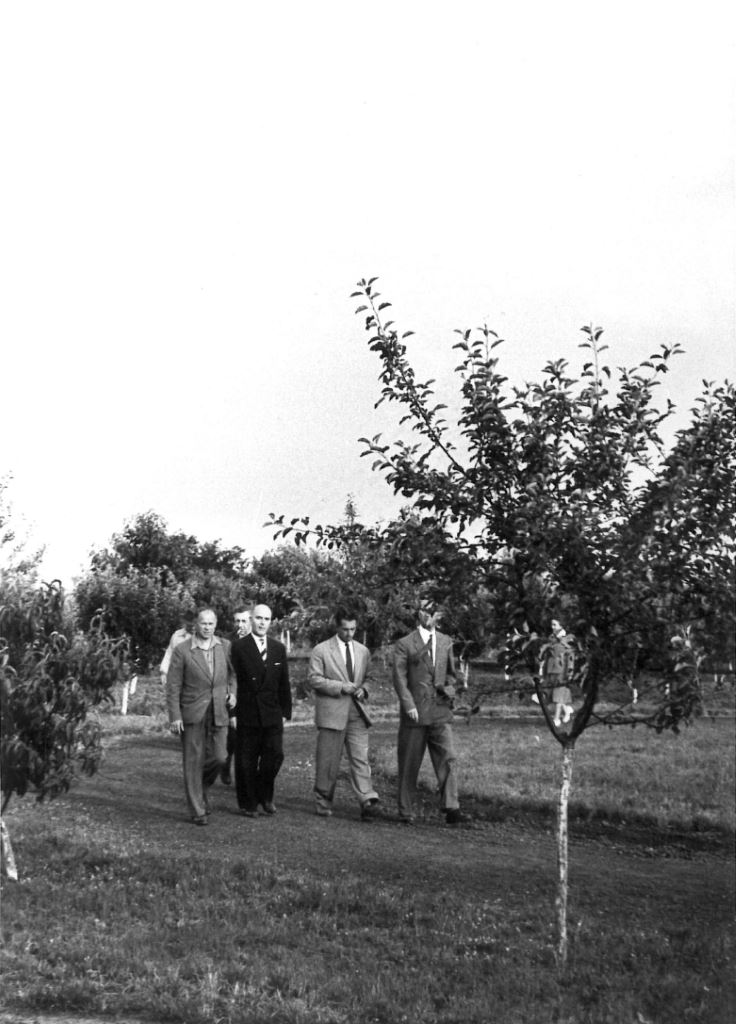

1958, FCI General Assembly, Belgrade, participants taking a walk
In 1959, Brazil becomes a full member. The total number of CACIB’s awarded is 4,006.
In Vienna, in 1960 (FCI President: Mr K. Worall), a new issue is raised, which still
affects cynology nowadays: the ear cropping and tail docking as mentioned in some
breed standards. The legal prohibition to do so in some countries creates problems
with regard to the observance of the standards of some breeds. Two years later,
it is observed that this new issue cannot result in discrimination when judging
the breeds in question.
1961 sees the adhering of Venezuela as associated member. At that period, the FCI
structure already comprises 7 working commissions, among which the Statutes Commission
which no longer exist nowadays.
From that period, early 60's, the statistics show a clear leadership of the show
scene vs the working scene. The Secretary General, Ch. Gendebien, will be insisting
on this unfortunate ratio. In 1962, the FCI includes 31 members and it is reported
that 235 breed standards have officially been registered by the FCI. The average
entry at shows is now more than 700 dogs.
The General Assembly of 1964 is celebrated in Stockholm in the frame of the 75 years
of the Swedish Kennel Club (SKK). The Assembly is chaired by the President H-J
Hansen.
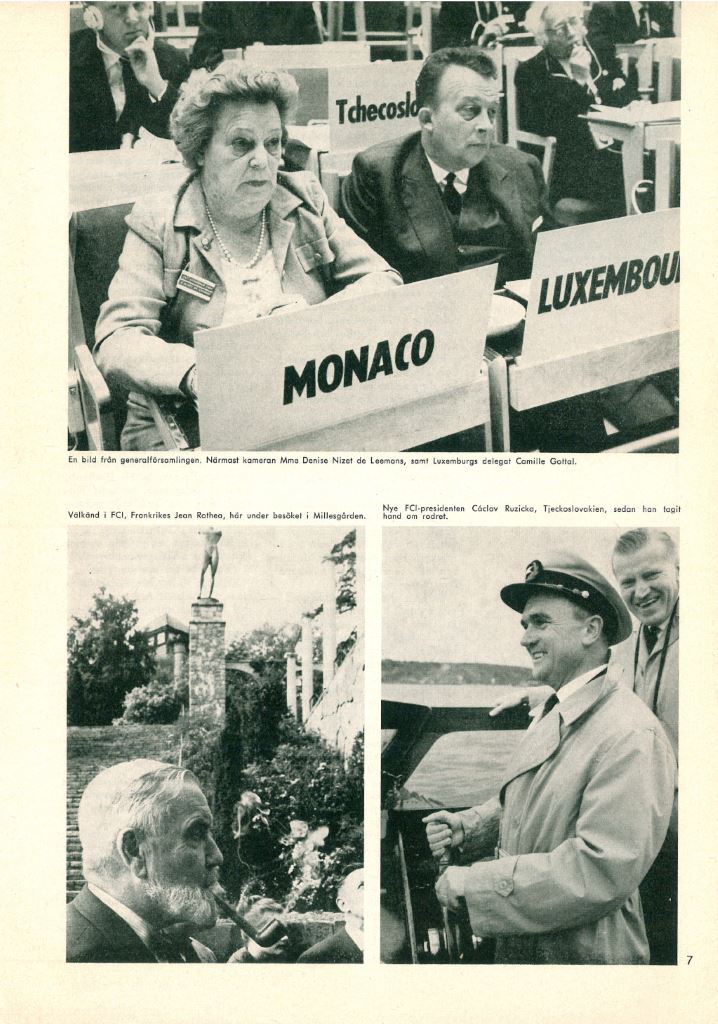

Mrs Denise Nizet de Leemans and Mr Camille Gottal, delegate from Luxembourg. Left: Well-known in France Mr Jean Rothea visiting Millesgarden. Right: The new FCI president Mr Vaclav Ruzicka, Czechoslovakia takes the rudder


1964 FCI General Assembly, Stockholm
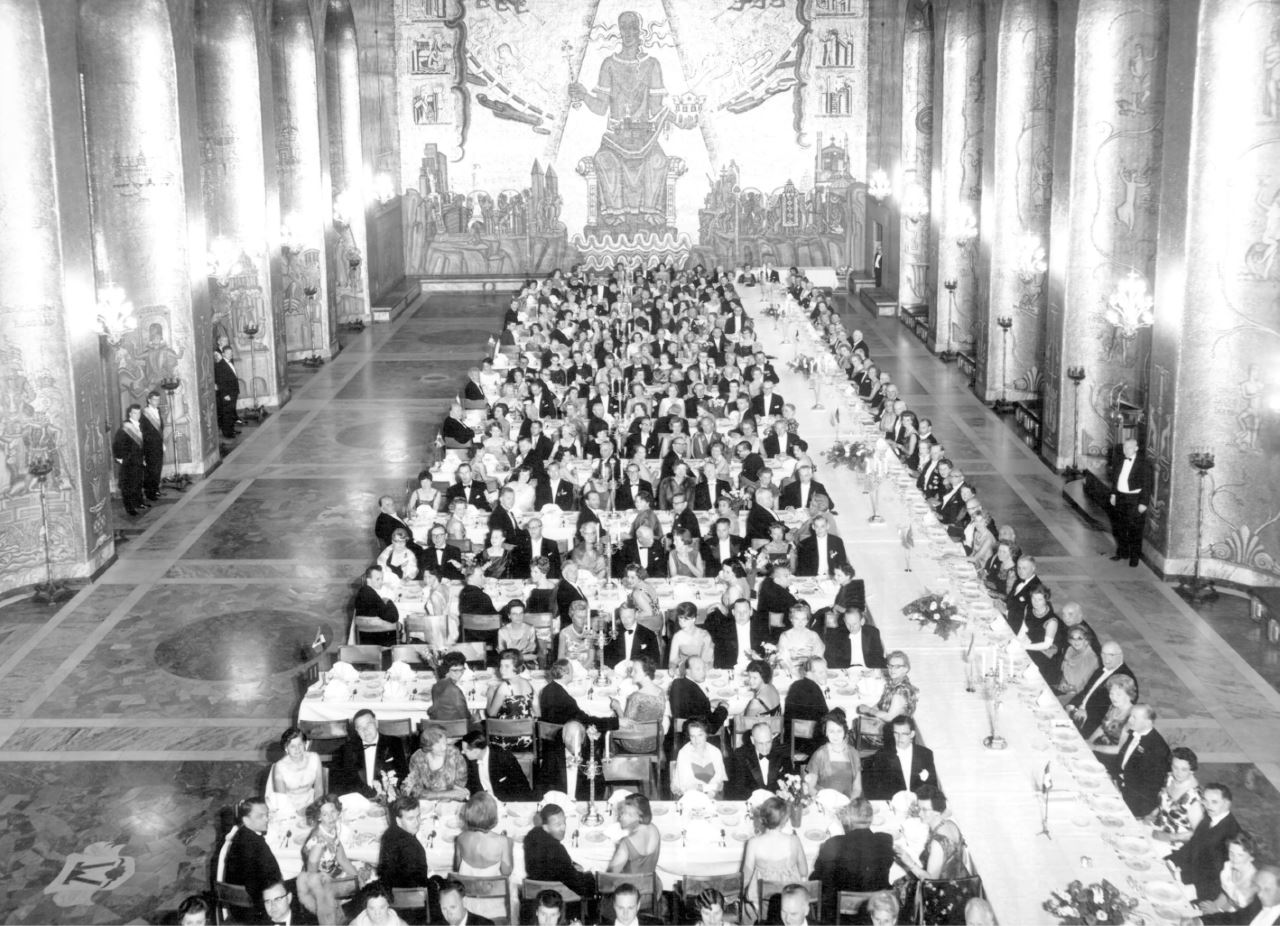

1964 FCI General Assembly, Stockholm, gala dinner for the 75 years of the SKK
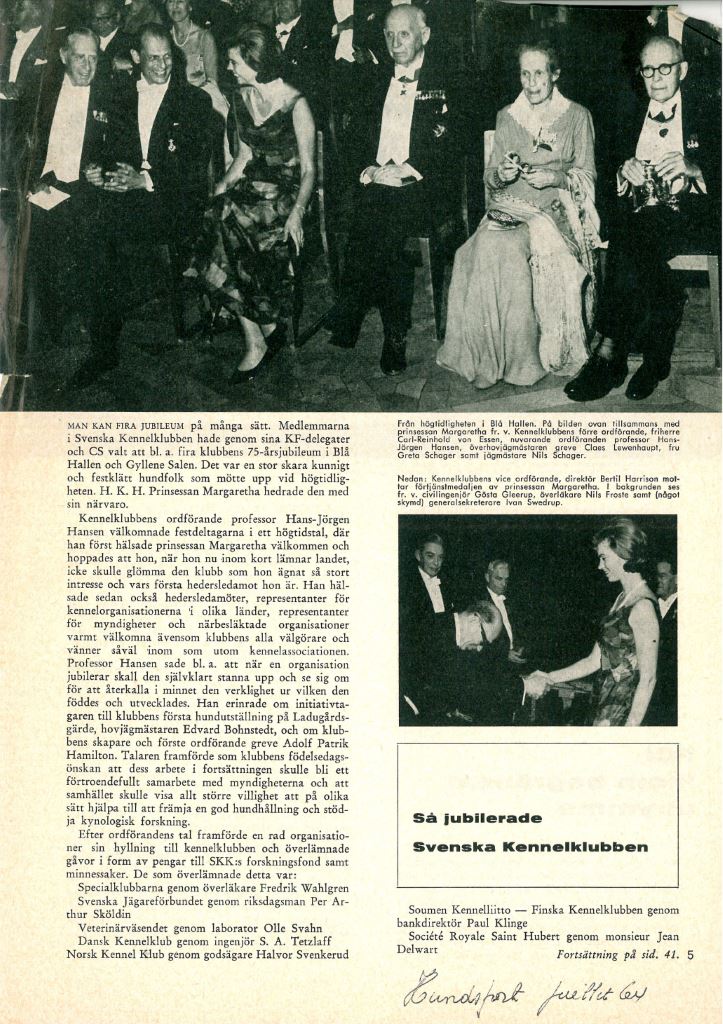

Upper photo: from the celebrations in Bla Hallen, together with Her Royal Highness Princess Margareta from the left, SKK former president Baron Carl-Reinhold von Essen, current president professor Hans-Jörgen Hansen, forest officer Claes Lewenhaupt, Mrs Greta Schager and forest officer Nils Schager. Lower photo: SKK vice-president Mr Bertil Harrison received medal of merit from Her Royal Highness Princess Margareta. In the background, Civil engineer Mr Gleerup, chief physician Nils Froste and SKKs General Secretary Mr Ivan Swedrup
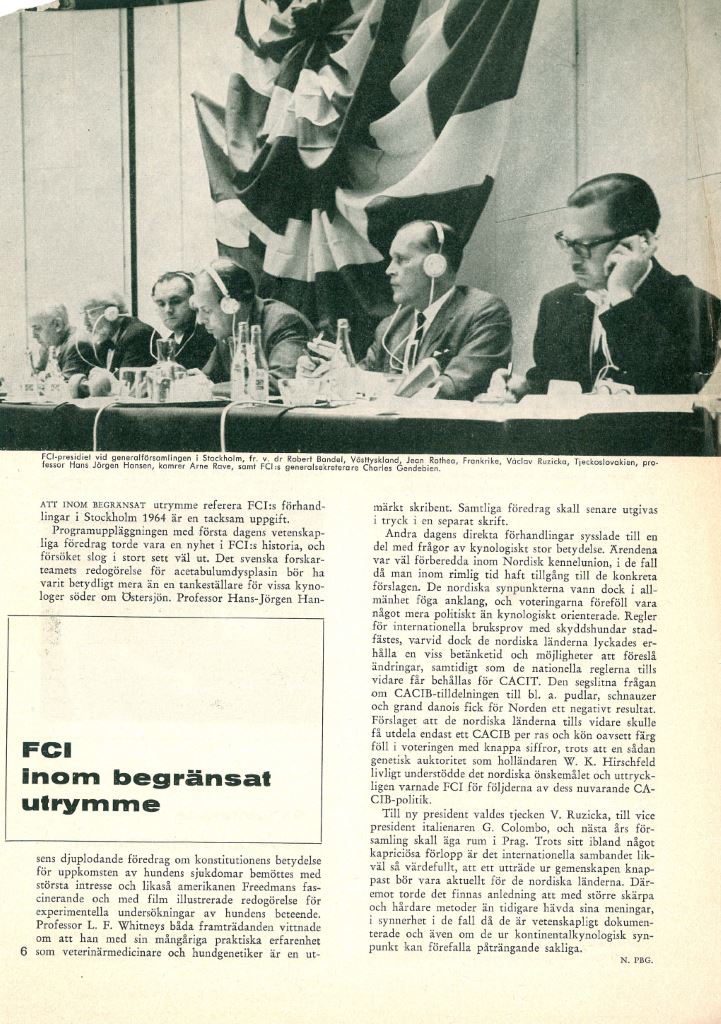

FCI presidency at the General Assembly in Stockholm, from the left Dr Robert Bandel, West-Germany, Mr Jean Rothea, France, Mr Vaclav Ruzicka, Czechoslovakia, Professor Hans-Jörgen Hansen, chief accountant Arne Rave and FCI General Secretary, Charles Gendebien
The matter of ear cropping and tail docking and its impact on breed standards remain
an issue for the FCI members and an important amendment to the FCI Statutes is adopted
to try to resolve it. The new principle requires “the observance of the breed standards
set by the country of origin of the breed, provided this is within the limits of
the laws of each country".
That year, the very first International Regulations for Utility Dogs are approved
and, for the first time, a long discussion takes place regarding whether or not
it is relevant to award different CACIB’s to different breed varieties (depending
if they can be mated or not).
In 1965, Prague (Czechoslovakia), two important statements are worth being mentioned:
Ch. Gendebien, FCI Secretary General: “a judge cannot judge at a show or a trial
organised by a dissident organisation” and “the FCI does not only want beautiful
dogs. Before all, we want that the dogs that get titles are those created by breeders
who produce beautiful and performing animals, which boils down to “dogs that are
nice to see and are as useful as they are beautiful”.
That year, the FCI also decides to revive the “Bulletin de la FCI” and to have its
own magazine and entrusts the editing house “ARTIA” to produce the “Revue Canine
Internationale” (Internationale Hunderevue). 50,000 copies of the first issue are
produced and then the production will be reduced to 22,000.
The General Assembly resolves that a dog that is already international champion
see its RCACIB transferred to the dog that was ranked second.
Milano is the host city of the FCI members in 1966. Once again, Ch. Gendebien insists
on the imbalance between the number of titles of CIB and CIT (respectively 397 vs
9). For the first time ever, the reports are translated into English and the «
international » specificity of the FCI is «confirmed » with 2,417, 2,589 and 2,937
FCI kennel names registered by the URCSH in 1963, 1964 and 1965. A decision which
still applies today is taken: the CACIB’s and CACIT’s cards awarded to dogs that
are already international champions will carry the note “RAPPEL”. That year also
sees the creation of the scientific commission.
While in 1958, 55 CACIB shows had been organised, in 1967, a mere 10 years later,
at the General Assembly of Monaco, the President Princess Antoinette of Monaco reports
that 93 beauty contests were held and 191 CACIT trials. As one can see, the FCI
members are more and more active and their number keeps growing as the FCI counts
21 federated and 13 associated members. On the occasion of this meeting, a “Model
of Breed Standard” is approved for the first time. It will be, as we all know, revised
and updated on two further opportunities later.


1967, Monaco, approval of the first model of breed standard
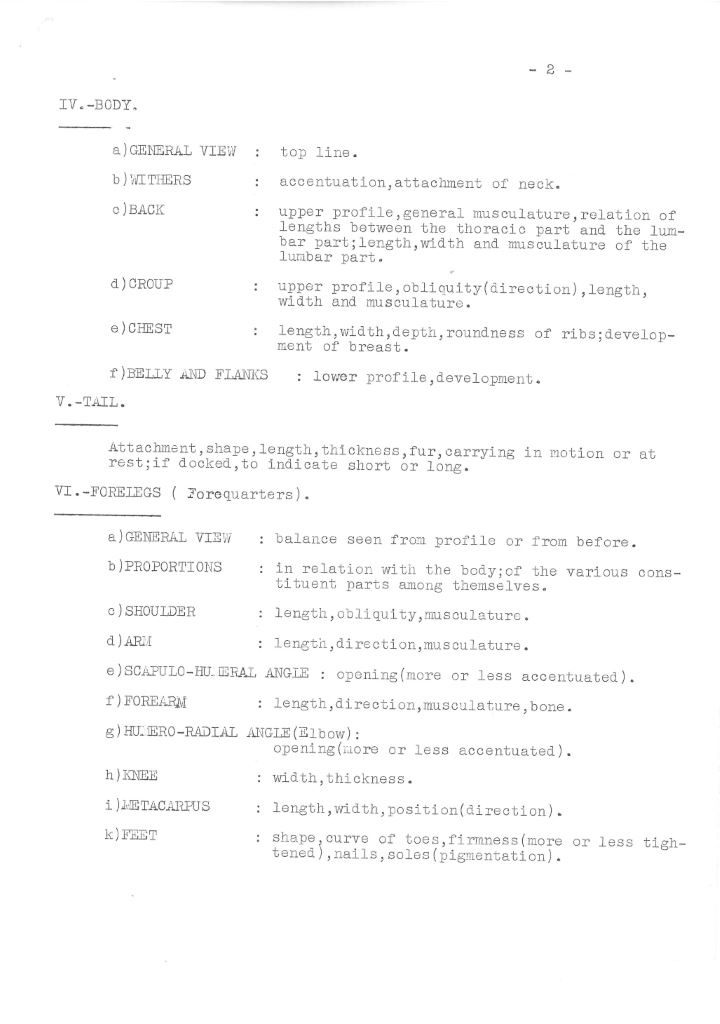

1967, Monaco, approval of the first model of breed standard
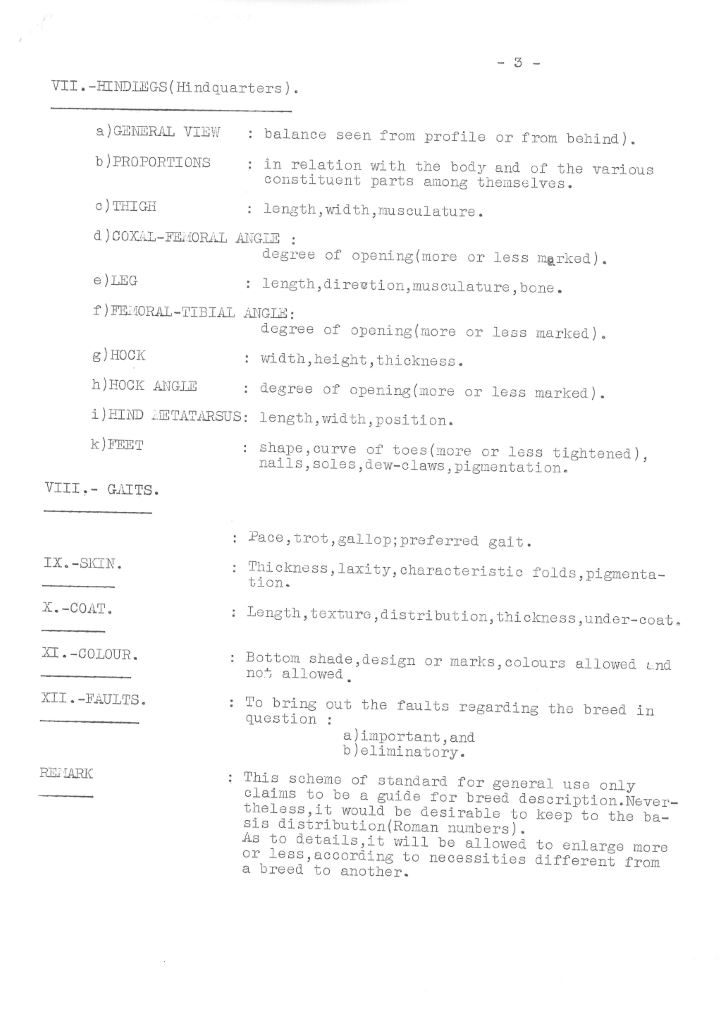

1967, Monaco, approval of the first model of breed standard
On March 5, 1968, the FCI is given the civil personality by royal decree.
Twelve months later, in 1969, at the General Assembly in Warsaw (President: E. Mikulski),
Mexico and Argentina become full members, whereas Paraguay gets the status of associated
member.
Illustrating once more how “global” the FCI is getting, the requirements for a dog
(outside Europe) to gain the title of CIB are set as follows: 4 CACIB under 4 different
judges (one of them should not come from the continent of the applying country).